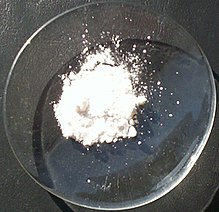
| |
 Caesium, Cs Carbon, C Oxygen, O | |

| |
| Names | |
|---|---|
| Preferred IUPAC name
Dicaesium carbonate | |
Other names
| |
| Identifiers | |
3D model (JSmol)
|
|
| ChemSpider | |
| ECHA InfoCard | 100.007.812 |
| EC Number |
|
PubChem CID
|
|
| UNII | |
CompTox Dashboard (EPA)
|
|
| |
| |
| Properties | |
| Cs2CO3 | |
| Molar mass | 325.819 g·mol−1 |
| Appearance | white powder |
| Density | 4.072 g/cm3 |
| Melting point | 610 °C (1,130 °F; 883 K) (decomposes) |
| 2605 g/L (15 °C) | |
| Solubility in ethanol | 110 g/L |
| Solubility in dimethylformamide | 119.6 g/L |
| Solubility in dimethyl sulfoxide | 361.7 g/L |
| Solubility in sulfolane | 394.2 g/L |
| Solubility in methylpyrrolidone | 723.3 g/L |
| −103.6·10−6 cm3/mol | |
| Hazards | |
| Flash point | Non-flammable |
| Related compounds | |
Other anions
|
Caesium bicarbonate |
Other cations
|
|
Except where otherwise noted, data are given for materials in their standard state (at 25 °C [77 °F], 100 kPa).
| |
Caesium carbonate or cesium carbonate is a chemical compound with the chemical formula Cs2CO3. It is white crystalline solid. Caesium carbonate has a high solubility in polar solvents such as water, ethanol and DMF. Its solubility is higher in organic solvents compared to other carbonates like potassium carbonate and sodium carbonate, although it remains quite insoluble in other organic solvents such as toluene, p-xylene, and chlorobenzene. This compound is used in organic synthesis as a base.[2] It also appears to have applications in energy conversion.
- ^ Weast, Robert C., ed. (1981). CRC Handbook of Chemistry and Physics (62nd ed.). Boca Raton, FL: CRC Press. p. B-91. ISBN 0-8493-0462-8..
- ^ Sivik, Mark R.; Ghosh, Arun K.; Sarkar, Anindya (2001). "Cesium Carbonate". Encyclopedia of Reagents for Organic Synthesis. pp. 1–12. doi:10.1002/047084289X.rc049.pub2. ISBN 9780470842898.